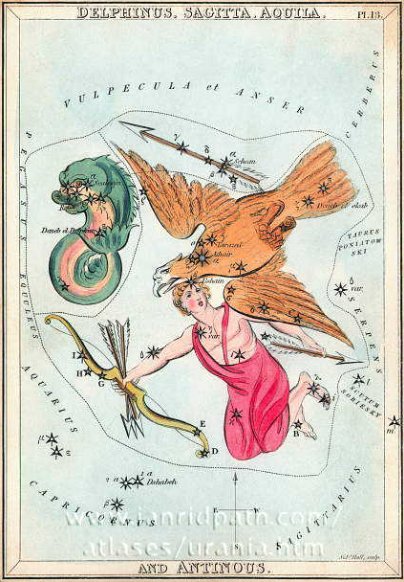I guess the main reason for there being no manzil Saad
Al Melik is that the star Sadalmelik was balancing exactly on the
line for 22h (although with a lower right ascension value in some
ancient time when this structural decision was taken):

The star
ι Aquarii is practically also
on this line which enabled me to draw the blue line for 22h.
The horizontal black-and-white
line drawn by Hevelius is the ecliptic and in relation to the sky
dome it is rising up towards declination 0º and reaching it not much
later than at the end of Aquarius.
|
Al Baldaah 2 (259) |
10 |
Al Baldaah 13 (270) |
8 |
Saad Al Thabib 9 (279) |
3 |
Saad Al Thabib 13 (283) |
|
January 30 (395) |
February 10 (406) |
February 19 (415) |
February 23 (419) |
 |
 |
 |
 |
|
Ca11-31 (315) |
Ca12-10 (326) |
Ca12-19 (335) |
Ca12-23 (339) |
|
te inoino |
ki hukiga o te ra |
koia ra kua haga hia |
mata hakatuu |
|
σ Pavonis (314.7),
Albali (314.8) |
Alphirk (325.7),
Sadalsud (325.9) |
22h (334.8) |
Sadachbia (338.6),
π Aquarii (339.5) |
|
Sadalmelik (334.6),
ι Aquarii (334.7),
Alnair (335.1) |
|
August 1 (213) |
August12 (224) |
August 21 (233) |
August 25 (237) |
|
Alhena 11 (77) |
Murzim 9 (88) |
An Nathra 5 (97) |
An Nathra 9 (101) |
|
no star listed |
A Hydrae (144.1) |
Regulus (152.7),
λ Hydrae (153.2) |
μ Hydrae (157.1) |
Therefore the nawaa Hameemain -
a region in time - may have been ruled by stars rising later than
22h, such as Sadachbia (γ) at the right elbow:
|
Nawaa |
Manzil |
Begins
on |
Number
of days |
Stars |
|
Ash
Shabt (Sagittarius) |
18 Al
Naam |
16 Jan
(381) |
13 |
257 |
Ascella
& Nunki (ζ, ς) |
|
19 Al
Baldaah |
29 Jan
(394) |
13 |
270 |
Al Baldah
(π) |
| |
|
The
Three Saads (Aquarius < 22h) |
20 Saad
Al Thabib |
11 Febr
(407) |
15 |
285 |
Saad Al
Thabih |
|
21 Saad
Balaa |
26 Febr
(422) |
13 |
298 |
Albali
(ε) |
|
22 Saad
Al Saud |
11 March
(435) |
13 |
311 |
Sadalsud
(β) |
|
22h |
Sadalmelik
(α) |
|
Hameemain
(Aquarius > 22h) |
23 Saad
Al Akhbia |
24 March
(448) |
13 |
324 |
Sadachbia (γ) |
|
24
Almuqaddam |
6 April
(461) |
13 |
337 |
Almuqaddam |
The
star 'Saad Al Thabih' should then belong
in the region < 22h and also rise earlier than Sadalsud (β)
at the left shoulder of Aquarius.
In
the Hindu list only Sadachbia (γ)
at the right arm is mentioned:
|
20 |
Purva
Ashadha |
δ and ε
Sagittarii |
Elephant
tusk, fan, winnowing basket |
|
21 |
Uttara
Ashadha |
ζ and σ
Sagittarii |
Elephant
tusk, small bed |
|
22 |
Abhijit |
α, ε,
and ζ Lyrae |
- |
|
23 |
Sravana |
α, β,
and γ Aquilae |
Ear or
Three Footprints |
|
24 |
Dhanishta |
α - δ
Delphini |
Drum or
flute |
|
25 |
Shatabisha |
γ
Aquarii |
Empty
circle, 1000 flowers or stars |
|
26 |
Purva
Bhādrapadā |
α and β
Pegasi |
Swords
or two front legs of funeral cot, man with two faces |
|
27 |
Uttara
Bhādrapadā |
γ Pegasi
and α Andromedae |
Twins,
back legs of funeral cot, snake in the water |
|
28 |
Revati |
ζ
Piscium |
Fish or
a pair of fish, drum |
There is no Aquarius star (worth mentioning)
before ε (Albali), and therefore the star
'Saad Al Thabib' should be in some earlier constellation. The
Hindu list mentions Lyra, Aquila, and the Dolphin between
Sagittarius (clearly ending with Al Baldah, π) and Albali - 2 bird constellations and 1
'fish' constellation.
But curiously Capricornus is not
mentioned.
At the end of his cycle Sun maybe should be
'down with the fishes' and I have decided to investigate the Dolphin
constellation in search for the star ruling the 20th manzil Saad
Al Thabib. However, the Dolpin is not down in
the 'Sea' but mysteriously up in the air:

|



